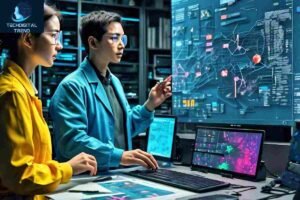Table of Contents
ToggleHuman-AI Collaboration
Human-AI collaboration is transforming the way we work and live. As AI technology advances, it’s enabling humans and machines to collaborate more effectively, leading to increased productivity, innovation, and progress. In this article, we’ll explore the latest advancements in human-AI collaboration systems, AI-powered human collaboration, and their applications.
Introduction to Human Artificial Intelligence Collaboration
The term “human-AI collaboration” describes the cooperation of artificial intelligence systems and people to accomplish shared objectives. It makes use of both human and machine capabilities to produce processes that are more productive and efficient. Many areas, including healthcare, banking, education, and more, can benefit from human-AI collaboration.
Human Artificial Intelligence Collaboration Systems
- Natural Language Processing (NLP): NLP is a technology that enables computers to understand, interpret, and generate human language. It’s used in virtual assistants, chatbots, and other applications to facilitate human artificial intelligence collaboration.
- Machine Learning (ML): ML is a technology that enables computers to learn from data and improve their performance over time. It’s used in predictive analytics, fraud detection, and other applications to facilitate human-AI collaboration.
- Computer Vision: Computer vision is a technology that enables computers to interpret and understand visual data from the world. It’s used in applications such as facial recognition, object detection, and image classification to facilitate human-AI collaboration.
AI-Powered Human Collaboration
- Predictive Maintenance: Predictive maintenance uses AI algorithms to analyze data from sensors and predict when equipment or machinery is likely to fail. This enables humans to take proactive maintenance actions and reduce downtime.
- Quality Control: Quality control uses AI algorithms to analyze data from sensors and detect anomalies or defects in products. This enables humans to take corrective action and improve product quality.
- Supply Chain Optimization: Supply chain optimization uses AI algorithms to analyze data from various sources and optimize supply chain operations. This enables humans to reduce costs, improve efficiency, and enhance customer satisfaction.
Human Artificial Intelligence Collaboration Applications
- Healthcare: Human-AI collaboration is used in healthcare to analyze medical data, diagnose diseases, and develop personalized treatment plans. It’s also used in drug discovery, medical imaging, and patient care.
- Finance: Human-AI collaboration is used in finance to analyze financial data, detect fraud, and make investment decisions. It’s also used in credit scoring, risk assessment, and portfolio management.
- Education: Human-AI collaboration is used in education to personalize learning, grade assignments, and develop virtual teaching assistants. It’s also used in student assessment, curriculum development, and educational research.
Benefits of Human Artificial Intelligence Collaboration
- Increased Productivity: Human-AI collaboration can increase productivity by automating routine tasks and enabling humans to focus on higher-value tasks.
- Improved Accuracy: Human-AI collaboration can improve accuracy by reducing the likelihood of human error and enabling machines to perform tasks with precision and accuracy.
- Enhanced Decision-Making: Human-AI collaboration can enhance decision-making by providing humans with data-driven insights and enabling them to make informed decisions.
- Improved Customer Experience: Human-AI collaboration can improve customer experience by enabling humans to provide personalized services and support.
Challenges of Human Artificial Intelligence Collaboration
- Data Quality: Human-AI collaboration requires high-quality data to produce accurate results. Poor data quality can lead to biased or inaccurate results.
- Explainability: In order to guarantee that people can comprehend how computers make judgments, human-AI collaboration needs explainability. Skepticism and distrust might result from things that are difficult to understand.
- Ethics: Human-AI collaboration requires ethical considerations to ensure that machines are aligned with human values and morals. The unethical use of machines can lead to harmful consequences.
- Training and Education: Human artificial intelligence collaboration requires training and education to ensure that humans have the skills and knowledge to work effectively with machines. Lack of training and education can lead to ineffective collaboration.
Conclusion
The potential for human-AI collaboration to revolutionize a range of sectors and areas of our lives makes it a potent instrument. We can provide more inventive, effective, and efficient solutions when we combine the talents of humans with machines. The difficulties and issues surrounding the cooperation of humans with AI, such as data quality, explainability, ethics, and training and education, must be taken into account.
We may use human artificial intelligence cooperation to build a better future by being aware of the most recent developments in AI-powered human collaboration, systems, and applications. Maintaining the integrity of human values and morality is just as important as studying and creating new human artificial intelligence collaboration technologies.
Open this link: Tap to here















